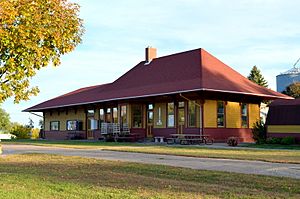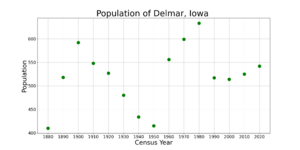Delmar, Iowa facts for kids
Quick facts for kids
Delmar, Iowa
|
|
|---|---|

|
|

Location of Delmar, Iowa
|
|
| Country | United States |
| State | Iowa |
| County | Clinton |
| Area | |
| • Total | 0.76 sq mi (1.98 km2) |
| • Land | 0.76 sq mi (1.98 km2) |
| • Water | 0.00 sq mi (0.00 km2) |
| Elevation | 820 ft (250 m) |
| Population
(2020)
|
|
| • Total | 542 |
| • Density | 709.42/sq mi (273.88/km2) |
| Time zone | UTC-6 (Central (CST)) |
| • Summer (DST) | UTC-5 (CDT) |
| ZIP code |
52037
|
| Area code(s) | 563 |
| FIPS code | 19-19720 |
| GNIS feature ID | 0455873 |
Delmar is a small city located in Clinton County, Iowa, in the United States. In 2020, about 542 people lived there.
Contents
History of Delmar
Delmar was officially started in 1871. This happened soon after a railroad line was built through the area. The city's name, Delmar, has a fun story! It's said to be a mix of the first letters of six ladies' names. These ladies were on the very first train that arrived at the station. Their names were Della, Emma, Laura, Marie, Anna, and Rose.
Geography of Delmar
Delmar is found at specific coordinates: 42 degrees, 0 minutes, 6 seconds North and 90 degrees, 36 minutes, 28 seconds West. These numbers help pinpoint its exact spot on a map.
The city covers a total area of about 0.76 square miles (1.98 square kilometers). All of this area is land, meaning there are no large lakes or rivers within the city limits.
Who Lives in Delmar?
This section tells us about the people who live in Delmar.
| Historical populations | ||
|---|---|---|
| Year | Pop. | ±% |
| 1880 | 410 | — |
| 1890 | 518 | +26.3% |
| 1900 | 592 | +14.3% |
| 1910 | 548 | −7.4% |
| 1920 | 527 | −3.8% |
| 1930 | 480 | −8.9% |
| 1940 | 434 | −9.6% |
| 1950 | 415 | −4.4% |
| 1960 | 556 | +34.0% |
| 1970 | 599 | +7.7% |
| 1980 | 633 | +5.7% |
| 1990 | 517 | −18.3% |
| 2000 | 514 | −0.6% |
| 2010 | 525 | +2.1% |
| 2020 | 542 | +3.2% |
| Source: and Iowa Data Center Source: |
||
Delmar's Population in 2020
In 2020, the census showed that 542 people lived in Delmar. There were 208 households, which are like homes where people live. Most people living in Delmar were White. A small number of people were Black or African American, Native American, or from two or more races. Some people were also of Hispanic or Latino background.
About 35 out of every 100 households had children under 18 living there. The average age of people in Delmar was about 35.9 years old. Many residents were under 20, and a good number were also 65 or older. The city had slightly more females than males.
Delmar's Population in 2010
Back in 2010, there were 525 people living in Delmar. There were 213 households. Most people were White. A small number of people were African American, Native American, or Asian. Some people were also of Hispanic or Latino background.
About 33 out of every 100 households had children under 18. The average age of people in Delmar was about 38.5 years old. Similar to 2020, the city had slightly more females than males.
Education in Delmar
Delmar has its own school system! In 1962, the Delmar and Elwood schools joined together to form the Delwood Community Schools.
Later, in the 1980s, Delwood schools started working with the nearby Maquoketa schools. This means that students in grades 7 through 12 (middle school and high school) go to school in Maquoketa. However, younger students, from Pre-Kindergarten up to 6th grade, still attend the Delwood School right in Delmar.
See also
 In Spanish: Delmar (Iowa) para niños
In Spanish: Delmar (Iowa) para niños


